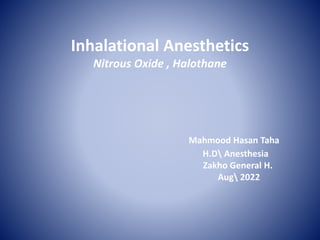
Inhalational Anesthetics; Nitrous Oxide and Halothane.pptx
- 1. Inhalational Anesthetics Nitrous Oxide , Halothane Mahmood Hasan Taha H.D Anesthesia Zakho General H. Aug 2022
- 2. Nitrous Oxide (N2O), Laugh Gas • Clear, colorless, non explosive , non flammable. • Supplied by pipeline or pressurized cylinders. • Boiling point -89ċ. • Gas at room temperature. • ≈ 5 times more rapid diffusion than N2. • Inexpensive.!!
- 3. • Safe ?, weak anesthetic but good analgesic. • No toxicity to Heart, Liver, Kidneys. • Prolong exposure to N2O → bone marrow depression (megaloblastic anemia) & peripheral neuropathies. • Teratogenic after long term uses. • MAC = 105
- 4. Effects on organ systems
- 5. Cardiovascular: • Minimal tendency to sympathetic stimulation. • Myocardial depression: caution in IHD & sever hypovolemia. • B.P, COP & HR unchanged or slightly increased.
- 6. Respiratory: • RR ↑ • Vt ↓ • Vm (-) • Diffusional hypoxia during recovery d.t elimination of N2O via alveolus is so rapid, this hypoxia can be prevented by administration of 100% O2 for 5-10 minute after discontinuing N2O.
- 7. Cerebral: • CBF ↑,CBV↑,ICP↑(mild), CMRO2 ↑. Renal: • GFR ↓ ,UOP ↓. Liver: • HBF ↓ < other volatile Anesthetics. Gastrointestinal: • PONV ↑ Neuromuscular: • ↑ potency of non depolarizing NMBA.
- 8. Contraindications: • Space occupying gas Brain? , Lung? , GIT? , ETT ? Pneumothorax, bullae, small bowel obstruction, middle ear surgery.
- 9. • Metabolism: 0.004%. • 70% nitrous oxide for >2hours have been shown to have more postoperative complications: atelectasis, fever, pneumonia, and wound infections. _______________
- 11. General Description: • Non flammable. • Non explosive. • Potent anesthetic. • Induction is pleasant. • Recovery delayed. • Shivering is common.
- 12. • Malignant hyperthermia & hepatitis ? • Rarely used nowadays. • MAC = 0.75 • Blood/ Gas: 2.3, Oil/ Gas: 224 • Boiling point 50.2℃, SVP 32.5 mmHg. • Color code: red. • Clear, colorless liquid in brown glass bottle.
- 13. • 0.1% Thymol as preservative to protect against decomposition by light. • The Thymol preservative does not readily evaporate, and therefore builds up in the vaporizer, which requires drainage and cleaning at regular intervals.
- 14. • Slightly water soluble. • Soda lime: compatible. • Halothane may corrode or tarnish most metals: with the exception of chromium , nickel and titanium; Halothane attacks aluminum, tin, lead, magnesium, brass and solder alloys in the presence of water; this contact causes rubber and some plastic materials to deteriorate rapidly.
- 16. • Suitable vaporizer: Old design: Goldman vaporizers. • Designed by an English physician Dr. Victor Goldman (1903b. – 1994d). tow models: 1956 - 1962. Modern and New design: a specifically calibrated plenum vaporizers e.g: (TEC3,4,5&7, Dräger Vapor, Penlon, Blease). The term plenum= pressurized chamber in which the FGF is above atmospheric pressure.
- 17. Goldman vaporizer (made in England)
- 18. TEC2 Cyprane Fluotec Vaporizer
- 19. TEC3 Cyprane Fluotec Vaporizer (out of circuit)
- 20. Accoma / Halothane Vaporizer made in Japan 1980s
- 21. Datex - Ohmeda TEC3(within the circuit) Halothane Vaporizer
- 22. Ohmeda Fluotec4/ Halothane Vaporizer
- 24. Datex Ohmeda Fluotec5/ Halothane Vaporizer
- 25. Dräger Vapor 19.1 / Halothane Vaporizer
- 26. Dräger Vapor 2000 – Halothane Vaporizer
- 27. Dräger Vapor 3000 – Halothane Vaporizer
- 28. Penlon, Sigma Delta – Halothane Vaporizer
- 29. Blease- Datum- Halothane Vaporizer
- 30. Datex - Omeda Tec7/ Halothane Vaporizer
- 31. Effects on organ systems
- 32. Cardiovascular: • Myocardial depression, COP ↓. • B.P ↓↓ → HR ↓. • At 2 MAC of Halothane without surgery, 50% reduction in COP & B.P.
- 33. • Coronary vasodilatation but coronary Blood flow reduced d.t. ↓ in MAP. • Adequate myocardial perfusion is usually maintained d.t ↓ in O2 consumption (↓ demand).
- 34. • Halothane sensitizes the heart to arrhythmogenic effect of epinephrine (epinephrine > 1.5 mcg/kg should be avoided).
- 35. Lidocaine HCl 2% with Epinephrine 20mg/10mcg per mL
- 37. Respiratory: •Non irritant. •Rapid, shallow breathing ( Vt ↓ , RR ↑). •Vm ↓ → ↑ PaCO2. •Apneic threshold ↑. •Good bronchodilator → safe in asthma. •Mucociliary function ↓ → post operative atelectasis & hypoxia.
- 38. Neuromuscular: • Adequate M.R for intubation of a child. • potentiate the non depolarizing (NMBA) action. • Malignant hyperthermia triggering.
- 39. Renal: RBF ↓, GFR↓ , UOP↓.
- 40. Liver: • HBF↓↓. • Halothane hepatitis: Extremely rare (1 : 35000). Multiple exposure at short interval. Middle age obese females. Family history. Personal history. Avoidance??
- 41. Uterus: Uterine relaxation. Others: Postoperative shivering is common.
- 42. Contraindications: • History of unexplained liver dysfunction, jaundice following prior administration. • Risk of triggering malignant hyperthermia. • With caution in neurosurgical procedure d.t ↑ ICP or ↑ CBF. • Hypovolemic patient or sever left ventricular failure. • With exogenous epinephrine or with pheochrom- ocytoma.
- 43. Drug Interaction: • Myocardial depression ↑↑ with B-blockers & Ca++ blockers. • Tricyclic antidep. & MAOI → ↑↓ (fluctuation) B.P & arrhythmias. • Halothane + aminophylline → serious ventricular arrhythmias.
- 44. Metabolism and elimination: • 60 -80 % unchanged via lungs. • 20% metabolized in liver (metabolites excreted in urine for several weeks).